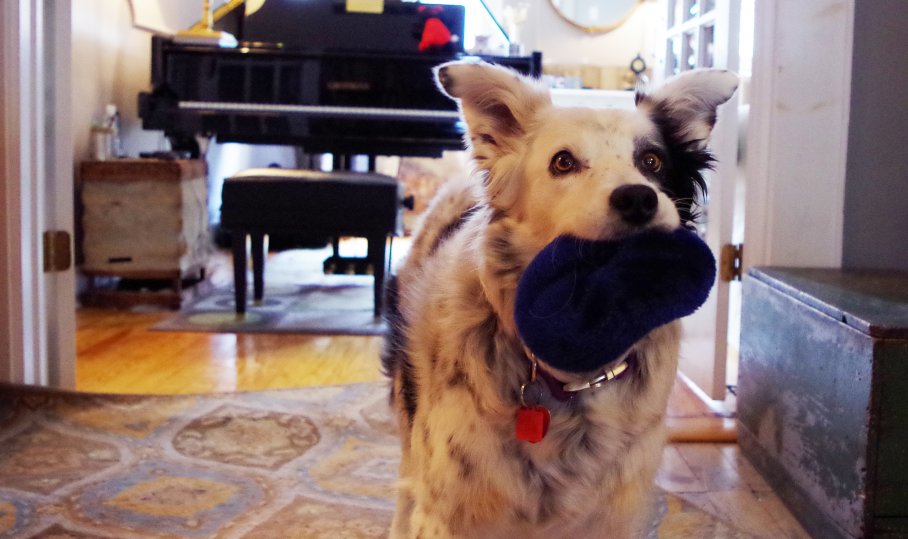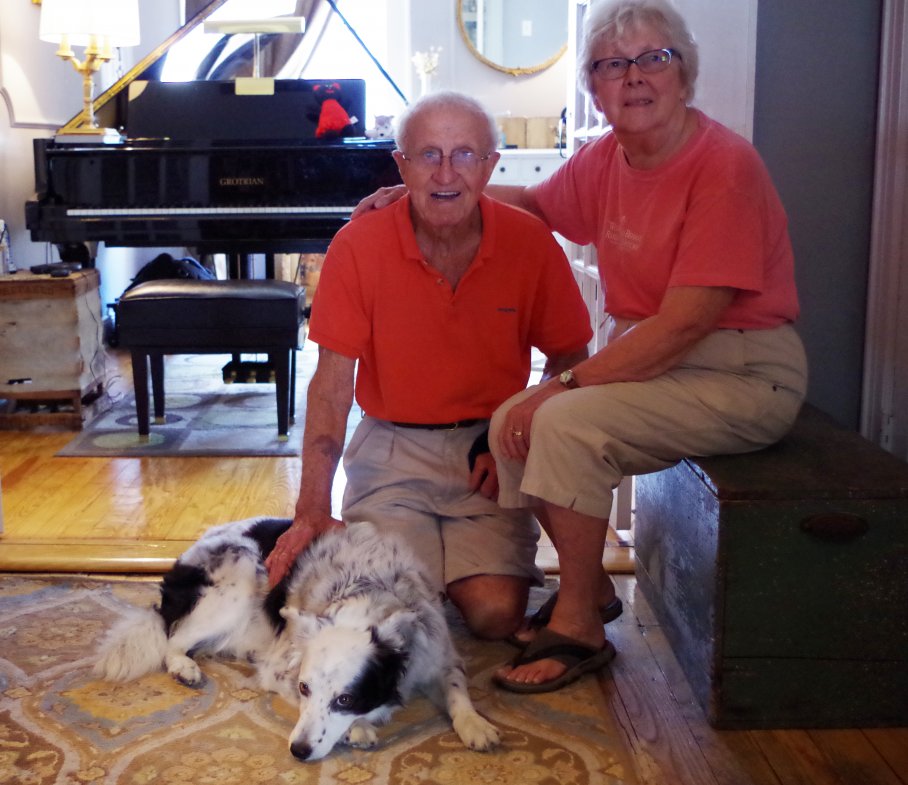Calvin’s Commentary: Every once in a while – actually about 4,000 times a day – I get so drained from what I hear on the news and read on the Net that I escape to my own happy little world of fluff, fur and fantasy. I pet my dog, Alexia, or read a poochie story on the Net, maybe both. I had to share this one with you. But first, here’s a quick pic of my dog, Alexia, and a link to a story I wrote about her here on my blog a while ago — and then right after that a great story about Chaser, the world’s smartest dog (whom I have never met, but the writer of the article did). I enjoyed it so I’m sure you will too! No other posts today. Just one for fun because you might be feeling spent and need a break too! We got Alexia from a rescue shelter when she was 7 months old. We knew she was mostly German Shepherd but didn’t realize she was part Border Collie until a “dog expert” identified her as having these two excellent breeds in one “perfect” dog! ▬ Donna Calvin ▬ Thursday, August 29, 2013

Warm and Fuzzy Story – Alexia, the Alert German Shepherd
(by Donna Calvin – a Personal Sharing)
Read about Alexia and our Smoke Detector: http://blog.beliefnet.com/watchwomanonthewall/?p=4241
~:~ ~:~ ~:~ ~:~ ~:~ ~:~ ~:~ ~:~ ~:~ ~:~ ~:~ ~:~ ~:~ ~:~ ~:~ ~:~
Proverbs 17:22
A merry heart doeth good like a medicine: but a broken spirit drieth the bones.
King James Bible
~:~ ~:~ ~:~ ~:~ ~:~ ~:~ ~:~ ~:~ ~:~ ~:~ ~:~ ~:~ ~:~ ~:~ ~:~ ~:~
I Met The World’s Smartest Dog
***************************************************************
Chaser isn’t just learning objects by name: she’s beginning to understand the basic structure of human language.
By Dan Nosowitz Posted 08.26.2013 at 1:29 pm
“Chaser, this is Dan. Chaser! This is Dan,” said Deb Pilley, a classical musician who goes by the name Pilley Bianchi professionally and signs her emails as “Pill.” Pill is the daughter of John Pilley, a former professor of psychology, who owns Chaser, an average-sized border collie mostly the color of cookies-and-cream ice cream, but with a black patch just to the left of her left eye. Standing in the entryway of Pill’s apartment, Chaser looked up at me with round amber eyes. “Hi there,” I said, and stuck my hand out for Chaser to smell. She did, briefly, then glanced at Pill, then turned around and ran upstairs to Pill’s apartment. The introduction was not dissimilar from a lot of introductions I’ve had at parties, except this time, I was meeting a dog.
Upstairs, in a spacious Williamsburg, Brooklyn apartment outfitted with mostly reclaimed and vintage furniture, were Chaser, John Pilley and his wife Sally. (Chaser usually lives with John and Sally in South Carolina.) For a couple of hours, I’d talk with John about Chaser, about border collies, animal intelligence, training, syntax, language, and how that all came together. But first was Chaser.
“Seriously? She understands ‘hot’ and ‘cold’?” “Oh, yes,” said John.
Border collies are the only dogs I like. They seem more self-reliant than other breeds, equally demanding of human attention but less demanding of human affection. They very rarely bark. They don’t jump on strangers. They don’t slobber. They are work dogs, not lap dogs. Border collies are herders, bred hundreds of years ago to work with sheep around the Anglo-Scottish border. They’re highly energetic, but it’s focused; they are, unlike many dogs, workaholics. In the absence of herding tasks, many, including Chaser, decide that their “job” is to play fetch. They’re not lackadaisical about fetch, getting the ball when they feel like it and giving it back at their leisure: they are impatient and demand the ball be thrown. This isn’t playtime. It’s work, and its in their genes. They’ll do it for hours, every day, and if they’re not allowed to “work” enough, they get bored, and then they get destructive. Throughout the recording of my interview with John, you can hear the bouncing of Chaser’s favorite ball, because the interview took place during her workday.
Pill has a magnet on her fridge that says “my border collie is smarter than your honor student.” It’s not quite true–Dr. Stanley Coren, author of The Intelligence of Dogs, estimates that a very bright dog like Chaser has the intelligence of about a two-and-a-half-year-old child. But I wanted to see just how smart she was.
Throughout the interview, Pill gave Chaser what I considered to be some pretty intricate directions. It was never “sit” or “stop,” but things like “relax” or “go to the living room,” which Chaser actually obeyed. These weren’t to impress me; this is the way John and Sally and Pill talk to Chaser. But I wanted to see some tricks.
I got a private demonstration with Chaser in Pill’s apartment, which seemed far too put-together for a rambunctious dog like Chaser to be running through. I was given a plush donut-shaped toy, the name of which I was told is “Fuzzy.” My first task: hide Fuzzy and have Chaser find it.
“Find” is a difficult test for an animal, because it is entirely based on the spoken word. It requires that the object to be found not actually be in sight, or else how could it be lost enough to be found? “Fetch” allows the dog to see the object as it’s thrown, but not “find.” Border collies aren’t natural hunting dogs like hounds, and all dogs have pretty short attention spans, so the task of finding an object seemed tricky to me.
I hid Fuzzy under a tall piece of wooden furniture, tucked way in the corner. There was only a few inches of space underneath there; Fuzzy wasn’t really in sight at all. It was too good of a hiding place. Chaser understood the task, but got frustrated quickly, almost like a toddler. She couldn’t find it. I repeated, at John’s urging, “Find Fuzzy, Chaser! Find Fuzzy!” in an excited tone. After a minute or two of Chaser scouring the apartment for Fuzzy, John told me to play the hot and cold game.
“Seriously? She understands ‘hot’ and ‘cold’?” I said. “Oh, yes,” said John. As she got closer to Fuzzy, I said “hot, Chaser! You’re getting hot!” She got more excited at this and began more energetically searching around that area. Just in case, she turned around briefly. “Cold, Chaser!” I said. She quickly turned back around, and within a few seconds had triumphantly located Fuzzy. She clawed him out from my unfairly difficult hiding place and looked up at me, eyes round, tail wagging, ears extended straight upward. “Good girl!” I said, before wondering how old a human child has to be before being able to accomplish that task.
Border collies are handsome, mid-sized dogs, so they’re popular for adoption, but are often abandoned or returned to shelters because owners can’t cope with their needs. If they can’t play fetch, or whatever they’ve decided is “work,” they’ll chew holes in walls, ruin furniture, and display signs of neurosis.
All of the border collies I’ve known have played fetch in this way, but I have never met one quite like Chaser. Her favorite toy and fetch object is a bouncy blue ball, which is named “Blue.” She is more dexterous than any dog I’ve ever seen; lots of dogs are too excited by the attention and the game to hand back the fetch object tactfully, instead wanting to play tug-of-war with it or just losing track of the game. Chaser would sit a couple of feet from me during the interview and very gently and precisely roll the ball at me with her nose. No games, no nonsense: here’s the ball back. Throw it again, please.
That need to work is key to understanding how Chaser has been able to learn more human language than any other non-primate–and, in fact, more than almost any primate. Chaser knows upwards of 1,200 words. Not just nouns, but also verbs and modifiers like adjectives and prepositions. John Pilley trained Chaser in an almost evolutionary way, looking at the specific needs and behaviors of the border collie breed and adjusting the teaching method to best suit it. That’s how, says Pilley, Chaser was able not just to learn so much human language, but to do it largely without food as a reward.
Pilley did his undergraduate work at Abilene Christian College and initially focused on religion; he holds a Bachelor’s of Divinity from there. “While I was in the ministry I earned a degree in counseling, and then went back for my Ph.D in psychology,” he says. A lifetime dog owner, he drifted into classical and operant conditioning–“Pavlov, Skinner, those guys,” he says–and eventually into the realm of animal cognition.
After watching border collies do the work for which they were bred–herding sheep–he noticed that the dogs were able to identify individual sheep by name. The farmers were able to tell their border collies to circle and guide specific sheep without visually referencing them at all. If it works for sheep, thought Pilley, why not for everyday objects? Most dog training is behavioral: “sit” and “lay down” and other commands that tell a dog to perform an action. To teach Chaser the names of objects, rather than commands, Pilley first tried a technique called “match to sample.” It requires two of a certain object. Pilley would place, say, a frisbee and a piece of rope on the ground. Then he’d hold up another, similar frisbee, and say “Chaser: fetch frisbee.” Chaser would recognize the visual similarity between the two objects, and begin to make the connection between the word and the object.
Correction: Match-to-sample was first tried on the dog that Pilley owned before Chaser, a border collie named Yasha.
I distinctly got the sense that she was thinking, and not just reacting.
That’s how most dogs (and other animals) are taught to identify objects. “It was too complicated,” says Pilley. “For most organisms, match-to-sample takes hundreds of trials.” His solution was to teach behaviors–verbs, essentially–first, and then make sure that the words Chaser was asked to learn actually had value to Chaser. “We know that herding is the primary instinct [for this breed], but there are many roles. Sometimes they have to find the prey, herd the prey, attack the prey, or kill. So anything that reinforces any of those behaviors is innately reinforcing.” Pilley adapted his reinforcements to suit what the border collie breed is bred to do. According to Pilley, Chaser can’t learn just anything, but the “find” command, which is much more complex than, say, “sit,” is a behavior that’s bred into Chaser. The act of finding something, in Pilley’s words, has value to Chaser. So no food rewards are necessary; Chaser is fulfilled by the task itself.
Each of the thousand or so objects Chaser knows has an individual name. These are usually nonsense words, like “Fuzzy” or “Bamboozel” (sic) or “Flipflopper.” But to Chaser, they might as well be the names of sheep.
This could be unusual to border collies. Ranking canine intelligence is a sticky business; Dr. Coren, for his book, ranked the dogs on their “working and obedience intelligence,” testing how quickly each breed could learn a command and how consistently each could demonstrate that knowledge. The border collie ranked highest, and the Afghan hound the lowest, but Coren is quick to note that intelligence is not any one thing, and that his ranking only applies to, basically, ability to respond to commands. The beagle, for example, ranks seventh from the bottom–a pretty dumb breed, according to the list. Yet these types of commands don’t play to the beagle’s strength; a member of the hound family, the beagle was bred as a hunting dog, trained to perform one task. Beagles are single-minded and determined, when tracking down a scent, but that was all they ever had to do–it was never necessary to understand and distinguish between multiple verbal commands. A border collie’s job, herding, is complex: move this sheep from this place to this place, keep a herd in a certain area, separate one sheep from the herd, divide the sheep into multiple groups, bring individual sheep to the herder. “Intelligence” doesn’t mean much, really; all way can say for sure is that border collies test extremely highly on a certain kind of obedience test.
Chaser has also been proven to retain the names of objects after learning them, even if she hasn’t seen them in years. The idea of naming individual objects and teaching a dog to identify them isn’t that new; Pilley and Chaser have certainly taken it to an extreme, but that’s not what gets Pilley’s psychology-sense tingling the most. What really excites him is the idea of teaching Chaser other elements of language: how words interact, how one word can modify another, and how words can signify more than one thing. Chaser is the first known dog to understand the concept of categories in human speech. If you tell her to “fetch ball,” and have set aside a ball, even if she’s never seen that specific ball before she’ll understand that the word “ball,” for her, refers to something round and bouncy. And fetch it.
Branching off from that is Chaser’s ability to make inferences. Say you set out three objects for her: one is a Fuzzy, one is a Bamboozel, and one is a New Balance sneaker. Chaser knows the first two objects, knows them by name, but has never seen that sneaker before. But tell her to “fetch New Balance,” and she’ll walk over to the three objects, puzzled, and analyze them for a second. She’ll walk among them, look at them carefully, and then gently grab the sneaker and bring it back to you–because she has figured out that she has to fetch something and this weird object is the only thing that could possibly match up with that weird sound you told her to fetch.
* * *
I have never met an animal quite like Chaser before, and I have met lots of animals. There is an intensity in Chaser’s eyes that’s similar to but brighter and stronger than other border collies; throughout my time with her, I distinctly got the sense that she was thinking, and not just reacting. When Pill told Chaser to “meet” me, she wasn’t being cute; Chaser looked at me, did her version of a handshake, noted that I was a human with whom she may interact, and then left.
Chaser seemed to almost be vibrating internally; even when, after being instructed to “relax,” she lay down and put her head on her paws, she still seemed ready to jump up and recite Chaucer, if that’s what was asked. She is friendly, and likes to meet new people, which not all border collies do, but also has that distinct autonomous trait. She doesn’t need warm, fuzzy attention from me; she needs work. When I told her to find Fuzzy, she appreciated that I was giving her a fun task, a new puzzle to figure out and then feel good about completing.
*
John Pilley’s book about Chaser, entitled Chaser: Unlocking the Genius of the Dog Who Knows a Thousand Words, comes out October 29th, but you can order it from Amazon now. It’s a good read!




